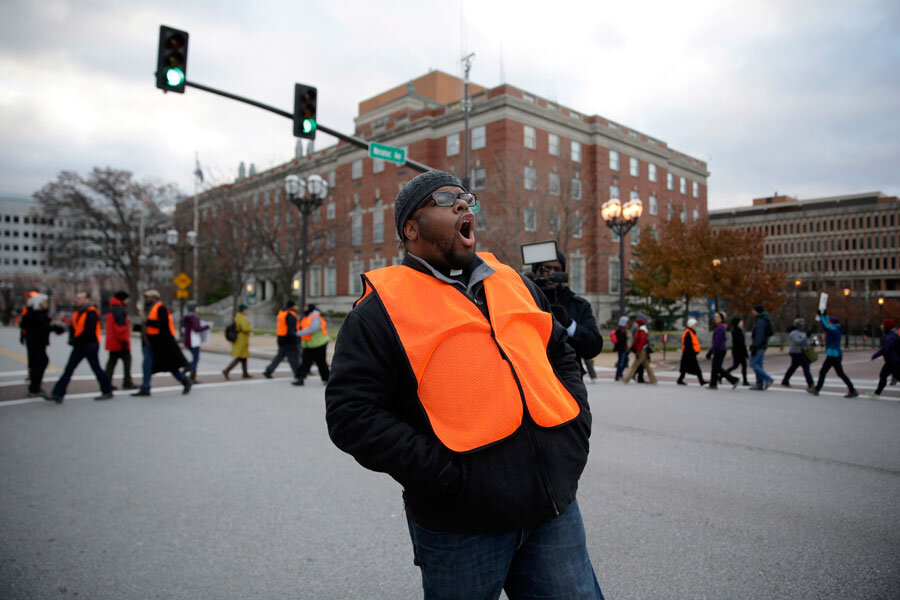Amid Ferguson's fire and anger, safe havens point to push for peace
Loading...
| CLAYTON, MO.
It's almost midnight, and while America is watching cars and businesses in Ferguson, Mo., burn, the converted living-room-turned-office of Veterans for Peace in neighboring Clayton is a safe haven, literally.
In the preparations for Monday's decision by a St. Louis County grand jury not to indict officer Darren Wilson for shooting and killing teenager Michael Brown, this was one of 19 sites set up to provide 24/7 support for weary protesters. There's medical assistance, snacks, and even legal support for anyone who might be arrested.
It is one part of a larger behind-the-scenes push to keep some measure of peace in Ferguson.
On Monday, the picture on the streets of Ferguson was disappointing for those at the Veterans for Peace safe haven. While civil disobedience had been planned, protests quickly turned to arson, looting, and gunshots. Police had to turn to smoke canisters to disperse crowds, and 14 people were injured.
But among the crowds were many activists determined to keep the protests as peaceful as possible. Police and organized activists had worked together during the past few weeks in anticipation of the grand jury decision, even negotiating 19 "rules of engagement" between police and those demonstrating against the shooting death of Michael Brown. Police agreed to eight general principles, including preserving human life and treating protesters like citizens rather than "enemy combatants."
Churches, meanwhile, set up safe havens and trained "deescalators" to rein in out-of-control protesters.
On Monday night at the Veterans for Peace office safe haven, a half dozen activists perched over three laptops, two iPads, and their own iPhones to to track developments through live feeds on Reddit and Twitter. One volunteer found a site that live-streamed a police scanner.
Like local authorities, the activists were shocked by the violence, burning buildings, and looting unfolding north in Ferguson.
When the office of St. Louis Alderman Antonio French, a black lawmaker who popularized the hashtag #HealSTL, burned to the ground, one older volunteer wearing a blue-and-white knit ski cap with hanging ear flaps, suggested a conspiracy. "That makes me think it couldn't be protesters, it must be someone else."
But Casey Stinemetz, chapter coordinator for the St. Louis office of Veterans for Peace, saw the hand of indiscriminate anger.
"It may very well be a bunch of youth, youth that are angry, who are not engaged with our stuff, with any organizing," says Ms. Stinemetz, one of the four women staffing the safe haven. "This might be the best way they think they can express themselves right now. I think it's hard to put ourselves in that situation, because none of us have ever been targeted by police violence."
Through Tuesday morning, there were at least 25 fires, including a pizza place, part of a storage complex, and two police cruisers, police said. Police, most dressed in riot gear, made 82 arrests.
"Our effort was to make sure nobody got hurt," said St. Louis Police Chief Sam Dalton at a Tuesday morning press conference.
That was Rabbi Micah Buck-Yael's job, too. As the chaplain at the Veterans for Peace office safe haven, she had been trained as a "deescalator."
"The role of the deescalator is two things," Rabbi Buck-Yael says. "They're outside on the front lines, acting as witnesses, using their visibility as members of the clergy to communicate to law enforcement that your actions are being watched, are being noticed by people who have a voice in our community, and who are going to use that voice."
Deescalators wear bright orange vests emblazoned with "CLERGY" in dark black letters.
"It's also to sort of to be in communication with people who are protesting," she continues, "and not in any way shape or form to direct or instruct, but sometimes to be able to share information, to help people take a minute to remember: these are your rights, these are the actions that will be grounds for arrest – make sure that you are staying safe and making decisions that are appropriate for you in this moment right now."
The group at the Veterans for Peace safe haven had also prepared to help those arrested with a "jail support teams" – making phone calls to have kids picked up for school, getting those arrested needed medicines, and helping round up bail money from friends and special designated funds.
By 3 a.m., when the Ferguson protests were fizzling out, the safe haven crew at Veterans for Peace was starting to gear up for another protest at 6:30 a.m. – albeit one here in slightly more well-heeled Clayton.
"In Clayton they probably won't have the tear gas and all the militarized police response," Stinemetz says. "That might scare all the fancy people."






